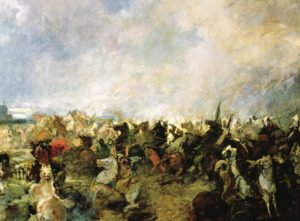711
Battle of Guadalete
As Muslim conquest of the southern shore of the Mediterranean proceeded, taking first Egypt, then Carthage, then Caesarea, it was inevitable that it would reach across the Straits to Spain. In 711, Arab and Berber forces from what is now Morocco, crossed the channel to the Visigothic kingdom, at the invitation of one of the factions in a civil war, and went on to subdue almost all of the Iberian peninsula.
The Visigoths were a Germanic tribe that had invaded Hispania in the 5th century, driving out other earlier northen intruders such as the Vandals (who left behind the name Andalusia — land of the Vandals) and the Suevi. They were Arian Christians when they first arrived but as they gradually became more civilized they adopted the Catholic religion of their subjects. Despite their faith, they remained a quarrelsome and murderous bunch, so fond of killing their own kings, that the Romans laughingly called assassination the morbus Gothicus, the Gothic Disease. It was one of their frequent tussles for the throne that the Muslim army was able to take advantage of.
The leader of the Arab-Berber army was Tariq ibn Ziyad (after whom Gibraltar – Jib-al-Tariq – is named). He probably did not suspect that his expedition would be so successful but it appears that the victory on this day at the Battle of Guadalete killed the Visigothic king Roderic and much of his warrior class, leaving a political vacuum which the Muslims exploited over the next couple of years. By 713-14 they had reached the Pyrenees, leaving only the northwest corner of Spain in the hands of Christians. The Moorish occupation of the peninsula would be ended only in 1492 with the fall of Granada to Ferdinand and Isabella.
